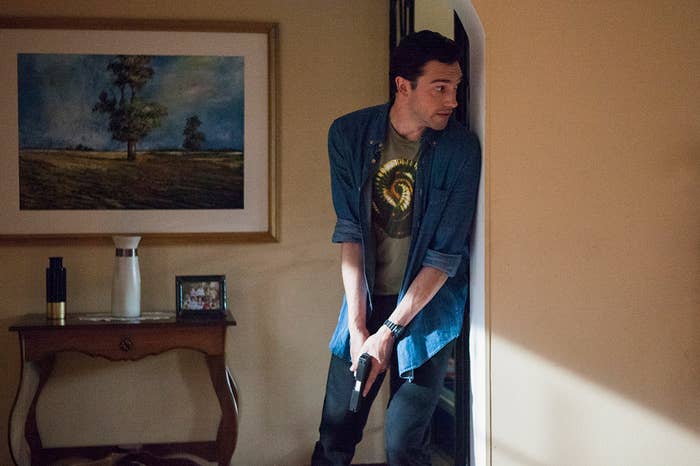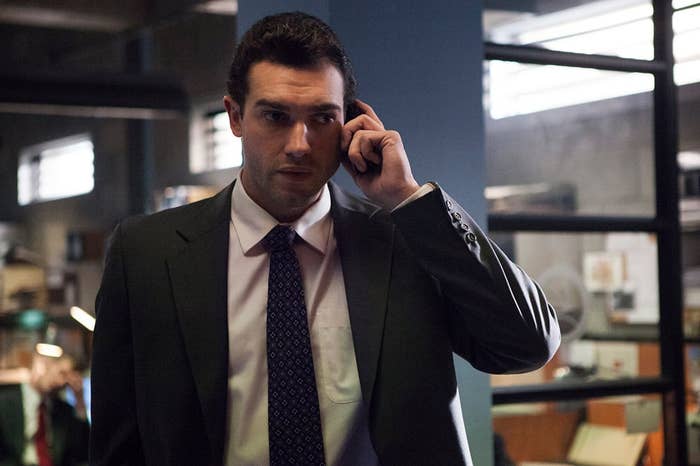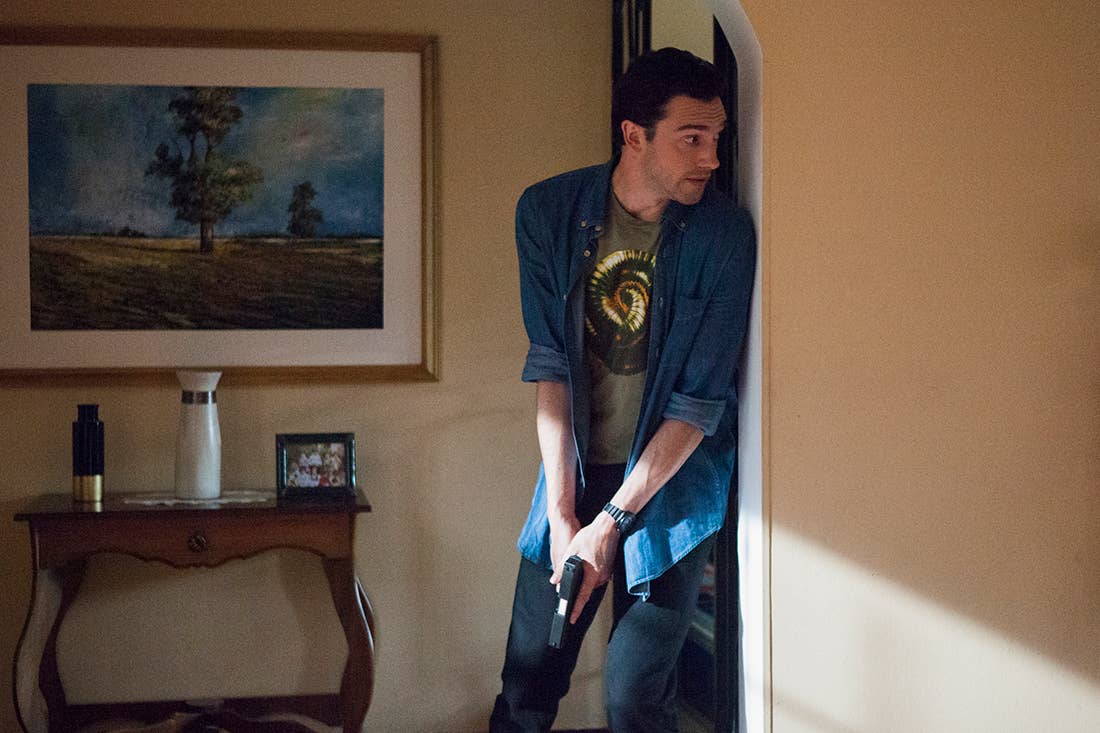
There are many things to be said about Narcos. Personally, I find that it’s the only show where I’m not flailing to hit the “skip intro” button – Rodrigo Amarante’s vocals are too sanguine and mesmerizing. His sinister lullaby “Tuyo” is overlaid with visuals of the stuff cartel dreams are made of: suitcases laden with cash and cocaine, alluring women, exotic animals, aerial shots showing the vast influence that only blood money can buy. Slotted in are real scenes of buildings, aflame, and corpses, slain in streets – a necessary reminder that cartels leave devastation in their wake, and must not be romanticised. Seasons one and two were set in the ‘80s – as denoted by the Reagan portrait hanging on a wall. During his tenure, Reagan prioritized the war on drugs, and was a loud supporter of extradition.
Season three’s opening montage reflects the new public enemies number one – the Cali Cartel – as well as the decade in which they reigned. 1993 marked the beginning of the Clinton administration – seen here in archival footage of Bill and Hillary, smiling and waving as they disembark a plane. A superimposed corpse looks on in the background. In November 1993, Clinton signed the North American Free Trade Agreement (NAFTA), which increased trading across the U.S.-Mexican border, and inadvertently opened up borders to illegal drugs. It was a deal made in narco heaven.
Predictably, season twoended with Pablo Escobar’s demise. Though show runners José Padilha and Eric Newman were clearly paving the way for a Cali Cartel takeover, fans remained apprehensive about a show without its main kingpin. New Zealand-born actor Matt Whelan, who joins the cast in season three, is very optimistic.
“I think if you’re up to date with the seasons, and have watched the end of season two, then it’s a very logical progression from the fall of Escobar,” Whelan says. “You will have been introduced to the Cali Cartel, and how they took advantage of the fall of the Medellin Cartel to become even more successful than Pablo. They have an incredible story to tell, and a completely different way of going about things. I think there’s as much intrigue and brutality as in the past two seasons.
There’s a certain coolness when they come along – the Cali Cartel – and not to glamourise it too much, but there is a different element to them.”
Gone are Escobar’s frumpy dad jumpers and sneans. The Godfathers of Cali, in their silk shirts, bespoke suits and oiled hair, are as suave as they are utterly terrifying.
All stylistic details get a facelift this season – even the soundtrack. The ‘90s birthed a new generation of hip-hop, and I challenge you now to find a better vessel for which to explore money, drugs, power, snitches, … females, the hustle, and so forth. The trailer for season three opens with the bullet-sounding drums of Bell Div Devoe’s “Poison”, and closes with Cypress Hill’s defiant “I Ain’t Going Out Like That”. Time will tell.
Escobar’s legacy is canon by now. But if you actually look at the numbers, the Cali Cartel were miles ahead. At his peak, Escobar was earning $4B per year. Cali earned $15B. They moved 340 tons of cocaine every year, and at one point were responsible for 80% of the world’s cocaine consumption. Unlike their predecessor, they preferred to stay out of the headlines, and away from the watchful eyes of the DEA. They certainly weren’t opposed to violence (a chilling scene involving chainsaws comes to mind), but preferred bribes over guns. They used the latest technologies – beepers, cell phones, wire-taps, million-dollar computers – to run their operations, and had cops, government officials, and even a future president on their payroll. As Agent Pena (Pedro Pascal) remarks, it was “Cocaine Incorporated, and they ran it like a Fortune 500 company”.

With four boss-men now in the mix – each with a fuse shorter than the last – the Cali Cartel arc becomes infinitely more engrossing than Escobar’s. There’s the founders – brothers Gilberto (Damian Alcazar), the “boss of bosses”, and Miguel Rodríguez Orejuela (Francisco Denis), the brains behind the operations. Their seconds-in-command are Pacho Herrera (Alberto Ammann), a hit man who runs the Mexican connection and international distribution, and Chepe Santacruz Londono (Pepe Rapazote) who heads the New York distribution network. Although they are family, the loyalty of the other three becomes compromised when Gilberto announces a plan to surrender to the authorities, in exchange for minimal sentences and a large retention of their wealth.
Erstwhile, Boyd Holbrook, who played Agent Steve Murphy, has left the show, leaving his partner Javier Pena to lead the assault. He’s flanked by two new, inexperienced agents: Chris Feistl (Michael Stahl-David) and Daniel Van Ness (Matt Whelan). With half, if not more of the show being in Spanish, Holbrook’s narration as Steve Murphy gave the show its American voice. It presented a bipartisan situation for the audience, reminding them that the ramifications of the war on drugs affect all. With Holbrook’s departure, this role has been handed to Pena.
“I loved seeing [Pedro Pascal] in that new leading role,” Whelan says of his co-star. “I think it was really cool for him to stay on board and take on the role of the voiceover – the driving force, I guess. He’s an incredibly talented and very sweet man, and I think he’s nailed it. I think everyone’s going to be really stoked to see what he does.”
Just as Murphy and Pena were two real-life agents that worked the Escobar case, Feistl and Dave Mitchell were responsible for bringing down the Cali Cartel (Whelan’s character was renamed for the show because Mitchell is still an active agent).
“I did a lot of research into the Cali Cartel, and also what it was like to be in the DEA. We had a good contact – Chris (Fiestl) – come down. I learned a lot about my character through him.”
Though Whelan may have found it exciting to research this role, his character Van Ness is very much unenthused about chasing the Cali Cartel.
“He has a history in the military, but now he’s moved onto the next stage of his career. He’s much happier being in the office than on the front line. Then he gets dragged into things, rather reluctantly, by Chris. It creates a lot of banter and tension between them, and ultimately strengthens their relationship. Throughout the course of the season, Daniel realizes that this is what he loves doing, and so becomes more driven and involved in the process of taking the Cali Cartel down.”
The show takes certain liberties for dramatic effect, but many of the events depicted are based in truth. (WARNING: SPOILER) In 1995, having successfully captured Gilberto, law enforcement turned their sights to his brother Miguel. With the help of an informant, they tracked him down to a high-rise apartment. A search squad scoured the complex, but could find no sign of him. They started tapping on surfaces and drilling into hollow areas. In the show, it’s Van Ness who, certain that Miguel is behind a wall, drills into it before smashing it with a sledgehammer. But before he can get to the petrified narco (whose flesh did actually meet the drill), dirty cops arrive and end the operation, citing a lack of warrant. It’s got to be the closest call since the Cuban Missile Crisis.
“He actually came out of that caleta (hidden room) with an injured shoulder – I couldn’t believe it when I read it. It was so close, and yet so far. It was amazing how much of an influence the cartel had over a lot of people: politicians, police, even taxi drivers… So many people were being paid off, and that’s how they ran their business so well.”
Narcos is filmed entirely in Colombia, imbibing as much of its rich history and unique landscape as possible. Cartel-linked guerilla factions took refuge within its lush rainforests; the coca plant was farmed on its expansive, arable land; the Cali Cartel conducted business across the urban sprawl of their namesake city.
“We shot most of season three in Bogota, mostly on location. Very little of it was shot in the studio. In Cali, we shot in a lot of places where real events took place, like in sicarios’ mansions – huge, extravagant mansions. After the cartel was brought down, a lot of these buildings became derelict and abandoned, because people feared moving in, for obvious reasons.
We spent a week with Chris (Feistl) on a tour of Cali, where he took us around to look at all the cartel houses, hideouts and buildings they raided. It was incredible being on the ground and going to these real locations, and I think it adds an extra level of authenticity to the show.”
Over $1 trillion has been spent since Nixon first declared the war on drugs in 1971. The Cali Cartel fell over two decades ago, but drug trafficking remains rampant, and is still destroying lives. What gives?
“The drug trade has been a huge part of Colombia’s history, and makes for a very interesting and intricate part of what the country is today. I think you have to take those small successes where you can, but ultimately it’s a force that keeps driving on. To quote the tagline of season three, ‘the blow must go on’.”
The new season airs on September 1.

